Alternate Duluths
 Co-written with Allen Richardson
Co-written with Allen Richardson
Dr. Mallard McPurdy disappeared in 2005 while surveying regional probability for the University of Minnesota Duluth’s short-lived Anomalies Department. A team led by Dr. Leon Oswald recovered McPurdy’s yellow pressure suit on Skyline Boulevard, but McPurdy remains at large. His suit contained video files from which the following transcriptions were made; we obtained these with a Freedom of Information Act request.
Duluth 1. Air analysis complete: Bacteria Spore, Origin Unknown. I hope these cheap-ass containment suits actually contain.
The dim, overcast light coming through my smeared faceplate told me little about season or time of day. “Dr. Oswald!” I screamed, weeping as the dread and isolation overwhelmed me. I put on a brave face, clenching my fists, unimpressed by the amount of courage I could muster.
I vigorously wiped at the faceplate until I made out basic shapes. Trees, a bowl-shaped park and a little bridge straddling two small bodies of water, rock formations in the near distance. I’d been here before. Skyline Drive, Twin Lake Park. Okay. At least I knew my location and distance from sea level in the hallucination or trance or whatever this was supposed to be.
I walked over to the tiny pond. A thick film was on the surface. I knelt and quickly tried to clear away a patch of water before scooping up handfuls and sloshing them against the helmet. It helped precious little. I kept brushing the film away from the water and abruptly dunked my head into the pond. At last I could see at least marginally.
I made my way over to the serpentine Skyline Drive which gave one of the town’s most breathtaking vistas, slogging along in the suit. The revulsion overtook me like a cresting wave as I saw the first corpse, down the hill aways high in a tree. The now-shrunken body in a man’s red outdoor jacket had died with his arms locked around the highest branches. Protruding from the forehead was a stalk about a foot long with a nub on the end.
There were similarly dead people at high points all across my view of the city, on rooftops, balconies, streetlamps, bridges, grain silos by the harbor, the antenna farm.
Duluth 2. It’s difficult to do anything but observe — not science so much as exploration, a purified empiricism — as I round a bend of warm, summertime Skyline, and suddenly I’m walking through the snow of what appears to be a permanently cold Duluth. It’s a heavenly city, crystalline ice formations sprout from all structures like shimmering cathedrals. I make my way down into the neighborhoods. Everyone prays and feasts together, and there are toasty temples and churches everywhere. Very little motor vehicle traffic, the streets were not even plowed. Bundled-up figures in long, thick, white, brown, and gray robes and snowshoes amble unhurriedly across the snow. Chimes hang from every porch, the whole city listening to the wind. A dogsled team cruises down Fourth Street. The streetlamps have the warm glow of Victorian gaslight and the houses feel welcoming. It’s dark all day but I don’t miss the sun. The smell of home-baked bread … I can even smell it through my pressure suit … Someone glides by on skis.
Duluth 3. A Duluth of fully actualized social policies and cultural mores based on sustainable development. Organic gardens in every back yard, steam heat derived from plasma, clean-burning vehicles, a functioning process of reaching consensus within the community about appropriate levels of environmental impact in all building decisions. A city with astonishing levels of plant life irrigated in a canal system fed by the lake — majestic trees alongside office buildings with promenades to skywalks and rail systems. I see archaic ski-lift technology adapted as a form of public transportation, people chatting amicably as they the take the lift home with their groceries a couple miles up the hill while airships leisurely cruise over the lake. I attempted to ascertain what historical events led to this outcome where certain kinds of familiar strife have been minimized. But the fields of probability are simply too sensitive to extract much usable information about how to affect what I still tend to think of as “the real Duluth.”
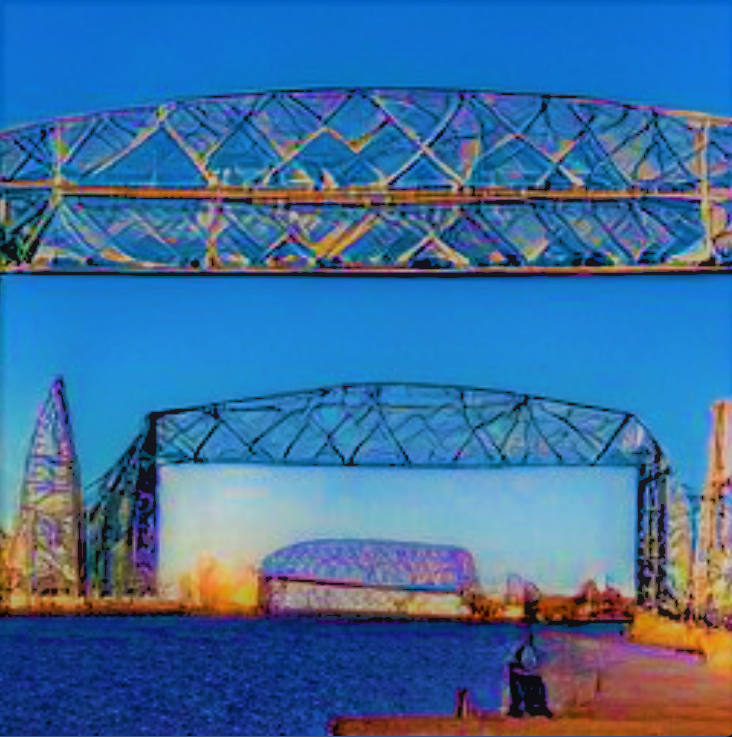
craiyon.com/Jim Richardson
Duluth 4. Ice Age Duluth scraped off the hillside by a glacier.
Duluth 5. Sprawling megalopolis Duluth, a city of fifty million in an unrecognizable nation.
Duluth 6. Arid conditions see most of North America looking like Arizona, and Duluth is a dusty frontier town full of desperadoes on a teeny lake. Migrant workers try to get over the border to the comparatively temperate Federated States of Canada, corrupt police in open warfare with a corrupt military for control of lucrative deals with drug-running paramilitaries and militias who will stop at nothing to get those fat Canadian dollars.
Duluth 7. Duluth where people never evolved, placid and untouched. Long-necked dinosaurs in the harbor.
Duluth 8-17. Files corrupted.
Duluth 18. Melting glaciers are blamed as Lake Superior outgrows its borders and floods the countryside. The city of Superior is completely drowned. Only the top of Duluth’s hillside remains, with the waves of Lake Superior lapping at Fourth Street. Park Point, Canal Park, the lift bridge, downtown, the west side, and both hospitals are lost to the surging tide. Duluth becomes the Venice of the Northland, people poling boats around over Third Street. Scuba-diving archeologists compete with mini-sub treasure hunters for the historical plunder of downtown and the government buildings. Duluth is now a Northlandic Atlantis.
Duluth 19. File erased.
Duluth 20. Duluth, a city amid dunes in a desert. The populace has adapted and snowmobile, ski, and snowboard over arid crests of sand. The lift bridge is buried by a marching dune which slopes away into the yawning chasm of heat mirages. Cargo ships like fallen monoliths are swamped in waves of sand, pitching and yawing imperceptibly over the decades, scoured by abrasive winds. The sky is white with the sun as a voice from a spired minaret calls people to prayer. Portions of a Lakewalk are still maintained, providing an excellent view of Sand Lake, the desert that is the former site of Lake Superior. I am haunted by the feeling that someone can see me.
Duluth 21. Superior Suckhole Mudpark. Corporate water pirates succeed in draining off Lake Superior in what is heralded as the greatest swindle of all time. Residents and tourists are invited to celebrate mud-based recreation. Bottled water for sale in abundance.
Duluth 22. Swamp Duluth. Earth’s axis tilts 90 degrees and Duluth is now on the equator. Duluth disappears like a lost Mayan city, grotesquely overgrown with jungle vegetation and wild animals. Vines strangle the lift bridge. Anacondas slither through storefront ruins. The air is filled with the cries and calls of exotic birds with ornate plumage. Abandoned cargo ships lay half-sunk in the harbor, now a haven for piranha and crocodiles. Snowplows rust ridiculously in the wet heat of crumbling city garages.
Duluth 23-35. Files corrupted.
Duluth 36. Duluth is torn by the unrest of a terrible civil war. Human rights are a joke as the populace is punished by all sides for perceived allegiances to the wrong factions. Tens of thousands are shot, raped, and thrown off of tall buildings. Helicopter gunships swirl through the city strafing farmer’s markets, schoolyards, and churches. Bodies dangle from the lift bridge, cargo ships burn in the harbor.
Duluth 37. Here Duluth has maintained the harsh winters of the pre-climate change era. The city freezes over as a miles-wide sheet of ice covers the town. Before long the Minnesota housewives have tunneled out and cleared the roads with their crème brulée torches.
Duluth 38-54. Files corrupted.
Duluth 55. The Red State Theocracy Army of America, an American Khmer Rouge spawned by NASCAR and 10,000 megachurches, rolls up through Wisconsin and besieges Duluth. The city council orders the bridges detonated to slow the advancing wave of crazed theists.
Duluth 56. I soar like a ghost over a largely deforested Duluth. Trees are the nuisance species of this time, doing nothing but blocking views and deeply-needed sunlight.
Trees are also an impediment to the free flow of capital and the economy. Duluth, once a fair city of green on a lush hillside, produces leaders for whom there are too many trees and not enough developments. One too many trees is uprooted and there is a deeply unsettling rumble as the hill gives way in a muddy landslide. Everything is decimated. Drowning in dirt and mud, the community smashed into the lake, leaving a barren slope of detritus and debris.
Duluth 57. Mountain-building geology goes wild. Duluth becomes a tenuous cliff city as the grade of the hillside gets exponentially steeper. Hiking from First Street to Second Street used to take a minute, but now you need a belay team, a thousand feet of rope, and an oxygen mask. I realize that, just trying to catch a bus, I am re-enacting the fatal expedition up the north face of the Eiger.
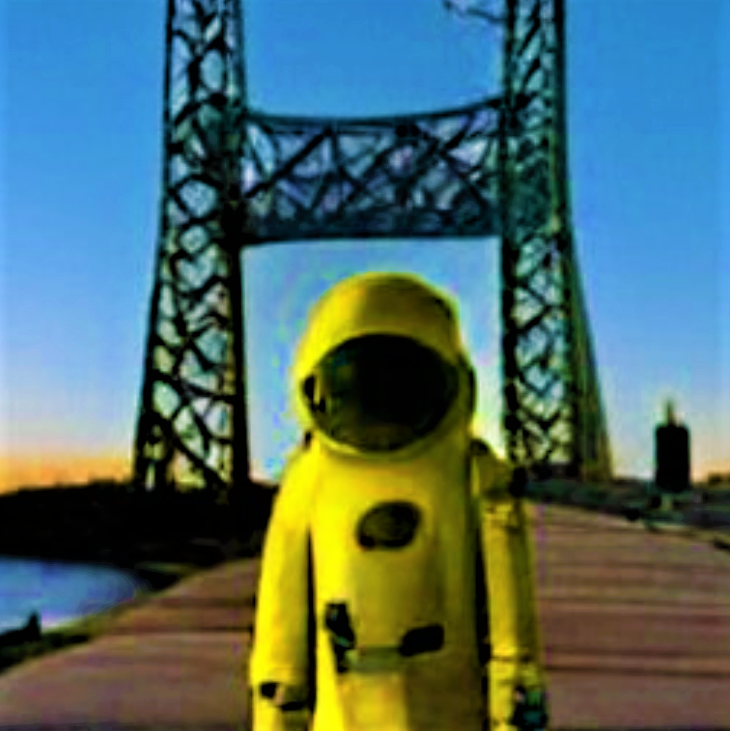
craiyon.com/Jim Richardson
Duluth 58-127. Files corrupted.
Duluth 128. The city is unknowingly built on a dormant volcano. The geological load builds as minerals and gasses leach to the surface. Eventually the mound is capped with a dome of lava-filled crust like a giant pustule beneath a thin membrane. Many residents and several volcanologists are killed the day Duluth erupts in a major cataclysm; the rocky skein rips open from seismic pressures. Molten rock explodes over the city and rains down at steep angles. Incandescent magma vents through neighborhood fissures, engulfing tricycles, cars, and homes. The citizenry flees before falling telephone poles and power lines; skyscrapers topple into the rushing elemental wave, helpless human cargo screaming and falling off the fire escapes. Office buildings deflate like sagging bagpipes, flames licking the masonry, plate glass blowing out. Duluth is a memory as a miles-wide swath of lava hisses into the lake.
Duluth 129. Ghost Town. The lake level falls catastrophically and the port industry is destroyed. No longer a tourist destination, the economy desiccates and Duluth dries up like an old husk. At night in the lakebed, archaeologists walk among the shipwrecks, half buried in sunbaked silt. I see the ghosts of ships at anchor floating 100 feet over their heads, waving like funeral banners.
Duluth 130. Nanotech experiment goes awry; Lake Superior turns into a space-age polymer.
Duluth 131. Duluth, Strangled City of Vines. I look down at green hell from the top floor of the Hilton. A couple of undergraduate biotechnology students at UMD’s Anomalies Department transgenically engineered kudzu for extreme cold hardiness and herbicide resistance, and their fraternity decided it would be hilarious to plant it in all the parks and green spaces. The results were catastrophic — the fledgling plants endured their first winter and became powerfully entrenched turning Duluth into an overgrown city of nightmare ivy. The growth rate of the kudzu is visible to the naked eye. Brigades of militias, prisoners, even domestic robots are enlisted to combat the green menace. The vines are relentless and there is speculation the growth rate is increasing. Neither plasma torches nor tillers nor tractors can halt the infestation. The city under siege and on the verge of panic, the city council authorizes an army of goats to be imported. The goats briefly hold the vines at bay but to the horror of the citizenry, the goats simply stop eating the kudzu one afternoon. Scientists believe the vines adapted to the goats by developing a taste too bad even for the notoriously indiscriminate omnivore. “Nothing can stop the vines.” The Skywalk becomes a lifeline for the strangled city, thick with foot traffic, the dingy windows surrounded by the green gripping mass which blocks the sun, tiny hungry tendrils exploiting the cracks in every structure. All the restaurants serve goat.
Duluth 132-150. Files corrupted.
Duluth 151. This Duluth of 1812 was a trading post with one muddy, half-frozen street. A trio of British warships came bearing down and if they captured it, the fur trade would be cut off and Manifest Destiny stopped in its tracks. But one ship stood in their way. Mothballed since its capture in 1777, the Crammenfjorder had been a mercenary vessel commandeered by the colonists in the Revolutionary War and given a high-tech retrofit.
The Crammenfjorder did a Crazy Ivan, whipping around in a tight little circle. It opened fire with the cannons on one side, then the tail cannon, then the cannons on the other side, presenting a continuous hail of iron shells. The British, also under sniper fire from the Hillside Irregulars on shore, turned tail.
I observed the scene like a ghost as the Crammenfjorder, perforated by a cannonball, listed badly and slid underwater. Even though he had changed history, Captain Buck Wild plunged into drunken recriminations as the water climbed the slanted deck and rose over his shoes: “Demoted to Great Lakes duty, I’ve projected my character flaws into the world: fatal sentimentality and poison anomie.”
Duluth 152. Four-star General Hardcheese at the Park Point Bunny Hearings. “I knew they were cute and fluffy. What I didn’t know was they were so highly trained in combat. I hereby tender my resignation. To be beaten back by a bunch of bunny rabbits is more than the military mind can bear … Swarmed by biting rabbits, rabbits gutting soldiers with their kicking clawing back feet, rabbits jumping everywhere, zooming around like guided missiles, ricocheting off trees and military vehicles; rabbits viciously clawing and biting their way through squads of riot police and armored personnel carriers … By God I was going to nuke Park Point but I was talked off the ledge by an apple-cheeked Private who put his hand on mine, gently easing it away from the red button as he spoke of America’s finest ideals. I later saw that same Private eaten alive by cute fluffy bunny rabbits. As the chopper lifted off the Embassy’s rooftop landing pad, he came running as if in slow motion, covered in silky rabbits inexorably pulling him down. As his hand just missed the landing skid of the ascending chopper, he shrieked ‘Don’t leave me!’ like a little girl and was erased from this cursed Earth beneath a tide of lil’ adorable soft fuzzy black white and brown puffballs. We were using an Amish mercenary side-gunner by the name of Menno Zwonk.”
Zwonk gives his testimony in a slow rumble like Quint in the movie Jaws: “Five or six of the wee bunnies leapt from his body and clung to the landing skids with all four legs, but I swung me heavy machine gun around and turned them into hamburger meat. But two of ‘em made it into the cabin. And to get ‘em, I had to cut the chopper in half with me red-hot smoking M-60, tracer bullets every fifth round. Damn if’n I didn’t kill me some wee bunnies that day.”
Duluth 153. Post-apocalyptic Duluth of the near future. An exodus of genre-bending whimsical creatures walks nervously through the shattered downtown. My Little Pony, Care Bears, fanciful morning television characters such as the Teletubbies, Boo-Bahs, and superhero babies; a gibbering horde of day-glo and primary-color infant-friendly monstrosities, a whirlwind of windswept fairies, mewling kitties with ponderously large eyes like whales, fluttering bluebirds and chickadees, pontificating talking animals in an endless torrent. A cavalcade of googly-eyed educational puppets and cartoons, each stretchier and more preposterous than the last, accompanied by bombastically cheerful Disney scores and dancing musical notes, growing ever more discordant and paranoid in the Mad Max milieu. The rustle of the wind makes the wide-eyed mewling kitties jump with fright, oversized features drooping with yet still more pitiful sadness. A scurrying rat in the distance brings their hearts into their mouths as they clutch each other for the barest thin feeling of a quickly unraveling security. Finally they are set upon by radioactive cannibal road warriors in dune buggies laced with razor wire. It looks hopeless, but unexpectedly the tide turns. The mewling kitties — were they always the size of lions? — may have deeply cute sad eyes as big around as dinner plates, but they have claws to match the length of Japanese wakasashi short swords. Releasing a long-stifled bloodlust, they rout the mutant punks with powerful wide slashes. A perky “hurray!” goes up among the whimsical creatures, but it quickly trails off and sags into a feeling of acute discomfort as the huge-eyed mewling kitties toy with their still-living prey before eating them. The Teletubbies thought they knew what savagery was. How wrong they were.
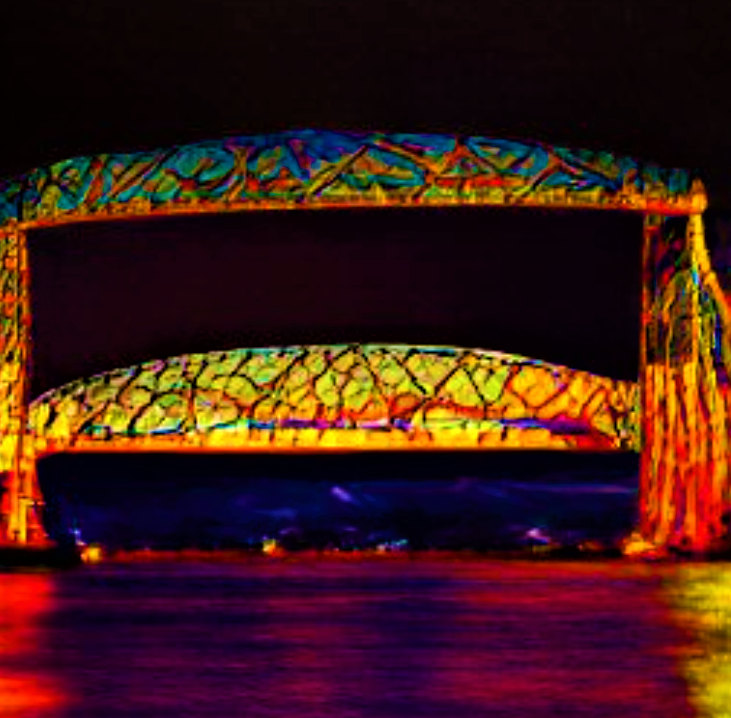
craiyon.com/Jim Richardson
Duluth 154-267. Files corrupted.
Duluth 268. Hovering in the air over Duluth, City of Bees. Bees are the dominant species and the entire hillside is a gargantuan honeycomb structure. The deafening hive is miles wide at the base with a mound fifty stories high at the presumed center, somewhere analogous to Lake Avenue and Superior Street, although it is difficult to get a sense of scale in the complete absence of familiar landmarks, and the disorienting effect of all the bees in the air. Different hive nodes develop as the system spreads its control of the landscape, on the march like a glacier. The shoreline is hard to distinguish; the bees live right up against the water and build high out over it like genius architects. I believe there may be a colossal colony of wasps in the endless flower fields of Wisconsin. The buzzing noise is deafening. Suddenly I am stung on the leg — there is a bee in my pressure suit! OW! I am stung again!! Oh no!! OW!! Stung again!!! How many bees are in here!?!!!! I have to get the hell out before these little bastards swarm my ass!!!! EJECT!!!! EJECT!!!! NO I MUSTN’T, IT MIGHT DESTROY THE WORLD!!!!
Duluth 269. Downtown infested with flying foxes.
Duluth 270. City of Birds: Airplane engines clogged with birds, earsplitting avian distress calls.
Duluth 271. I am walking in dust. Everything’s hazy brown, I can barely see my feet through my faceplate, grit blowing everywhere, a few cars still in the street, no visible signs of people. This is an order of magnitude drier than most desertified Duluths I have seen — the atmosphere is completely devoid of moisture. I see a mummy in a car, looks like beef jerky in a police officer’s uniform. The buildings are packed with dried people wearing expressions of calamity. Studied with my suit’s instruments, it appears this Duluth fell victim to an unprecedented meteorological event. No out-of-the-ordinary radiation detected, no way to tell if it was particular to northern Minnesota or the whole planet. Was the lake pulled into space? Gravity feels slightly lighter somehow. Maybe it’s just creeping dread and horror. Alien moisture pirates? My throat is parched and I feel my skin constricting, adding to my fear that the suit is compromised and failing. I see a shape in the distance out on the lake bed. I enhance the focus of my faceplate until I can make it out: a dead giant squid wrapped around a half-buried submarine. I better get the fuck outta here. I close my eyes.
Duluth 272-703. Files corrupted.
Duluth 704. Catastrophic algae bloom. Lake Superior is covered in hideous slime, total ecosystem disruptions, and increasingly, giant squids.
Duluth 705. Ecclesia and I on a date enjoying nice drinks at Lake Avenue Café. We are seated in a booth by the full-wall window. Quiet night in Canal Park, low traffic, few pedestrians, sun has just set. I am confident, suave, aroused, we have chemistry. I sip my dirty martini through the straw interface. She squirms provocatively, bats her lashes, flips her hair. She wants to lay me.
She delicately applies her lips to the cocktail straw sticking out of her Cosmo and looks me in the eyes as she sips. I am really turned on, redemption close. I see something move in the bottom of her drink and look at it quizzically. She still drinks from the straw and I see it again; paralyzing fear descends on me. A soft wet sound on the window, a light rain.
The tiny tentacled shape circles the bottom of her glass as she laughs in a cutesy way, continues to drink. I say nothing, overcome with self-loathing, more wet sounds on the window. I turn my head to see it is raining tiny squids the size of tree frogs, slapping horribly plap-plap-plap-plap, the reddish gray-and-white squids covered in slick mucus.
Some stick briefly to the window and slowly ooze and turn end-over-end before falling to writhe on the sidewalk. Tourists run in horror. The rain ends abruptly, the streets, sidewalks and cars covered with a carpet of squids the size of fists, some as large as grapefruits, glistening under the pale streetlamp light like miscarried fetuses.
I look at Ecclesia. An obscene mass passes up her straw as she smiles in oblivion. I watch her blankly as she swallows the tiny squid. She reacts in horror which turns to medical distress.
Duluth 706. I am shaken to find myself on an airborne landmass over Lake Superior. I’m walking on the flying island as though familiar, as though I’ve been here before. I look over the edge. The island is high over an 800-foot cargo ship on its way from filling up with taconite ore. I watch in horror as the freighter is enveloped by the colossal tentacles of an impossibly huge squid. The sound of groaning metal and the ship’s siren dimly reaches me.
Duluth 707. I wake up face down in the grass on another flying island. I walk slowly toward the edge, wind whipping my hair. This place is different. I instinctively believe myself to be above Lake Superior but there are no landmarks. It comes into horrifying relief as I approach: no land, no water. As far as the eye can see in every direction are tentacles of every shape and size, trillions of squids in a squirming tangled mass. Then I know they can see me — the landscape becomes tentacles reaching into the air. Some are so huge and thick they might be able to reach the flying island, which begins crumbling and losing altitude.
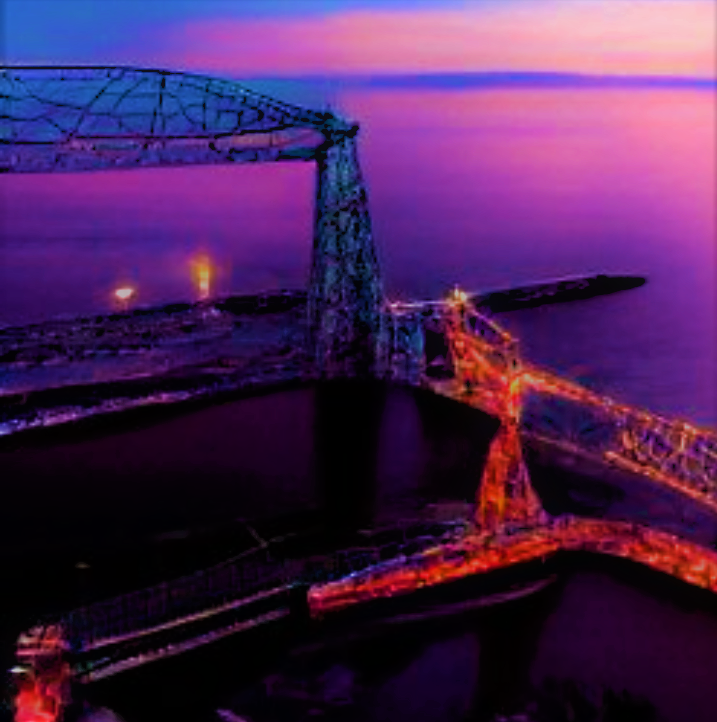
craiyon.com/Jim Richardson
A serialized version of this article originally appeared in the Transistor. Find more Richardson essays here.
Recommended Links:
Leave a Comment
Only registered members can post a comment , Login / Register Here



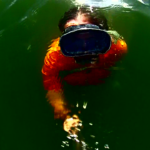










2 Comments
Jim Goodman
about 2 years agoJim Richardson (aka Lake Superior Aquaman)
about 2 years ago